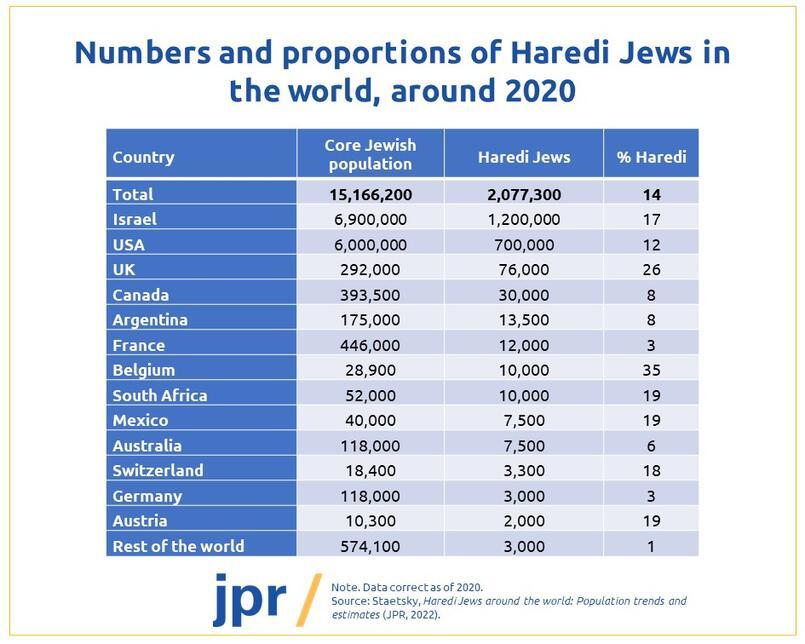The growth of the Haredi population is changing the nature of the Jewish world. How should community leaders on both side of the divide manage it?
Dr Jonathan Boyd
and test your family's knowledge of Jews worldwide while reading the Haggadah!
Dr Jonathan Boyd
The global data are in. There are 2.1 million charedi Jews in the world today, comprising one in seven of the world’s Jewish population. By 2040 they are projected to reach about 4 million and comprise at least one in five. That’s not speculation; it’s about as certain as any demographic projection ever gets.
The figures in the UK are even more striking. About 80,000 charedi Jews live in the country, constituting about one in four of the whole. In fact, charedi Jews comprise a larger fraction of the total Jewish population in the UK than in any other country in the world, bar Belgium. And by 2040, the proportion here will be closer to one in three.
It’s difficult to imagine what these demographic changes will mean for Jews in Britain. The community has grown used to a certain status quo, whereby modern orthodoxy holds centre stage as represented by the United Synagogue and the Chief Rabbi, and where non-orthodox forms of Judaism are fully included in umbrella frameworks such as the Board of Deputies and Jewish Leadership Council. Theological differences persist of course, and occasionally cause tensions, but for the main part, we tend to live and let live in a – how can I put this? – very British kind of way.
In the meantime, in a parallel world, charedi Jews have been getting on with their lives. Long seen as marginal by the mainstream, the assumption there has often been that the charedi community is largely a remnant of pre-modern Judaism that belongs to a former age. The resultant view has often been one of disengagement; they wouldn’t want to talk to us, and we’d rather steer clear anyway, so probably best just to ignore them and wait for their inevitable demise.
Except that demise isn’t going to happen. On the contrary, the charedi community is growing rapidly. And assuming no imminent vast wave of charedi migration from Britain, that growth means that the type of Jewishness that occupies centre stage in the years to come is very likely to change. The Jewish religious ‘Overton Window’ will move, positioning a more halachic, observant and separatist type of Judaism at the heart of British Jewish life.

Research in the field of cultural geography helps us to see what may happen next. One possibility is that a numerically dominant and strident form of strict Orthodoxy adopts a kind of imperialist model, where it either takes over the existing representative bodies or establishes its own, drives out or ignores all non-charedi voices, and takes control of representing Jewish interests to the state. In response, non-charedi communities either relinquish their position or push back, before being numerically overwhelmed, leaving all forms of non-charedi Judaism mere shadows of their former selves.
Another possibility is that a schism occurs. Two distinct forms of Judaism emerge, each one developing its own ideas and practices, until such time as they no longer recognise one another at all. Schisms are rarely pleasant: the divorce would likely be messy, the recriminations fierce, and the hostility enduring.
The third possibility is convergence. Both forms of Judaism borrow from one another, adopting some of the norms and behaviours of the other, until a new type of Judaism emerges. This is what often happens when two cultures rub up against one another. To give one example, Jews in New York have become increasingly American over time, but New York has become increasingly Jewish too. Similarly, some cultural aspects of charedi Judaism will be adopted by non-charedi forms of Judaism, and vice versa. So some degree of intra-Jewish convergence between charedi and non-charedi forms of Judaism could happen; indeed, to some degree, it already is.
Put simply, the three most obvious possibilities are domination, separation or adaptation. I see hints of all three happening already, but which one will ultimately win out is unclear. Yet charedi and non-charedi community leaders need to be aware: the demographic writing is on the wall. Seismic shifts in the denominational composition of the Jewish community are occurring. The only real question is: how do we want to manage them?
Executive Director
Executive Director
Jonathan has been Executive Director of JPR since 2010, having previously held research and policy positions at the JDC International Centre for Community Development in...
Read more